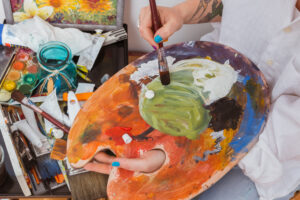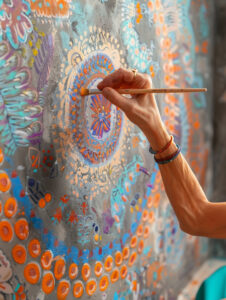Art and culture are two sides of the same coin, intricately linked and mutually reinforcing. They shape our understanding of the world and reflect our deepest values and beliefs. In this exploration, we will dive into how art and culture interact and influence one another. Together, they create a rich tapestry that defines human experience.

The Essence of Art and Culture
To begin with, let’s define art and culture. Art is a broad term that encompasses various forms of human expression including visual arts, music, literature, theater, and dance. It is often characterized by creativity and imagination and serves as a means to communicate ideas, emotions, and experiences. Culture, on the other hand, refers to the collective customs, traditions, and social behaviors of a particular group of people. It includes language, rituals, cuisine, and other practices that define a community’s way of life.
The Role of Art in Reflecting Culture
Art serves as a mirror to culture. It reflects the values, beliefs, and experiences of a society. For example, ancient Egyptian art, with its focus on gods and the afterlife, provides insight into the religious and cultural priorities of that civilization. Similarly, Renaissance art in Europe. characterized by a renewed interest in classical themes and humanism. reflects the cultural shifts of the time.
Through art, we gain insight into historical events, social structures, and everyday life of different cultures. A painting, sculpture, or even a piece of music can tell us about the technological advancements, social hierarchies, and philosophical ideas prevalent during its creation.
Culture’s Influence on Art
Conversely, culture influences art in profound ways. The traditions, values, and norms of a society often dictate the themes and forms that are popular or acceptable. For instance, traditional Japanese art such as Ukiyo-e prints reflects the cultural appreciation for nature and the fleeting moments of life. In contrast, contemporary art forms, such as digital installations and performance art, reflect the values of modern, globalized societies where technology and innovation play crucial roles.
Cultural events and historical contexts also shape artistic expression. During times of political turmoil or social change, art often becomes a means of protest or commentary. For example, during the 20th century, movements such as Dadaism and Surrealism emerged in response to the horrors of war and the disillusionment of the time. These art forms challenged conventional aesthetics and questioned societal norms, reflecting the turbulent cultural landscape.
The Intersection of Tradition and Innovation
One of the fascinating aspects of art and culture is the way they balance tradition with innovation. Traditional art forms, such as classical music, traditional dances, or ancient crafts, carry the legacy of past generations and preserve cultural heritage. At the same time, contemporary artists often draw on these traditions while incorporating modern techniques and perspectives.
Take, for example, the fusion of traditional and modern styles in music. Genres like jazz and hip-hop have their roots in specific cultural and historical contexts but have evolved to include influences from various cultures around the world. This blending creates new forms of expression that resonate with diverse audiences while paying homage to their origins.

Art as a Catalyst for Cultural Change
Art does not merely reflect culture; it can also drive cultural change. Through provocative works that challenge existing norms and ideas, art can inspire people to think differently and question the status quo. For instance, the feminist art movement of the 1970s sought to address issues of gender inequality and bring attention to women’s experiences, significantly impacting cultural attitudes and discussions.
Similarly, literature and cinema have the power to influence societal views and behaviors. Books like Harper Lee’s “To Kill a Mockingbird” and films like “The Pursuit of Happyness” address social issues and contribute to cultural conversations about race, poverty, and justice. These works of art can spark dialogue and promote empathy, leading to shifts in public opinion and policy.
Globalization and Cultural Exchange
In today’s globalized world, the exchange of art and culture across borders is more prevalent than ever. This interconnectedness allows for a richer exchange of ideas and influences. For instance, the popularity of K-pop, a genre of music from South Korea, has led to a greater appreciation for Korean culture worldwide. Similarly, Western art movements have influenced artists in other parts of the world, creating a dynamic interplay of styles and traditions.
However, globalization also raises concerns about cultural homogenization, where dominant cultures may overshadow or assimilate smaller or indigenous cultures. It’s essential to approach cultural exchange with sensitivity and respect for the unique contributions of all cultures. This helps ensure that diverse voices and traditions are preserved.
The Future of Art and Culture
As we look to the future, the relationship between art and culture will continue to evolve. Technology will play an increasingly significant role, influencing how art is created, shared, and experienced. Digital art, virtual reality, and interactive installations are just a few examples of how technology is transforming artistic practices and cultural engagement.
Moreover, as societies become more diverse and interconnected, the fusion of different cultural elements will likely produce new forms of artistic expression. This blending of influences can lead to innovative and exciting developments in art while also promoting greater understanding and appreciation among different cultures.
Conclusion
In essence, art and culture are deeply intertwined, each enriching and influencing the other. . Together, they create a vibrant and ever-evolving tapestry that reflects our shared human experience.
UnderstanArt provides a window into the values and experiences of different cultures.
while culture shapes the forms and themes of artistic expression. Ding the dynamic relationship between art and culture allows us to appreciate the richness of human creativity. It also highlights the diversity of cultural expression. As we move forward, embracing this interplay will help us navigate and celebrate the complexities of our global society. This ensures that both art and culture continue to inspire and connect us all.
For more videos please go to https://www.youtube.com.
Leave a Reply